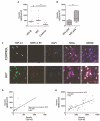Human Endogenous Retrovirus-K and TDP-43 Expression Bridges ALS and HIV Neuropathology
- PMID: 29075249
- PMCID: PMC5641584
- DOI: 10.3389/fmicb.2017.01986
Human Endogenous Retrovirus-K and TDP-43 Expression Bridges ALS and HIV Neuropathology
Abstract
Despite the repetitive association of endogenous retroviruses in human disease, the mechanisms behind their pathological contributions remain to be resolved. Here we discuss how neuronal human endogenous retrovirus-K (HERV-K) expression in human immunodeficiency virus (HIV)-infected individuals is a distinct pathological aspect of HIV-associated neurological conditions, such as HIV encephalitis and HIV-associated neurocognitive disorders. Enhanced neuronal HERV-K levels were observed in the majority of HIV-infected individuals, and to a higher degree in brain tissue marked by HIV replication. Moreover, we highlight an important neuropathological overlap between amyotrophic lateral sclerosis and HIV encephalitis, that being the formation of neurotoxic TDP-43 deposits in neurons. Herein, we argue for enhanced transdisciplinary research in the field of ERV biology, using an example of how HERV-K expression has novel mechanistic and therapeutic implications for HIV neuropathology.
Keywords: NeuroAIDS; TDP-43; amyotrophic lateral sclerosis (ALS); human endogenous retrovirus-K (HERV-K); human immunodeficiency virus (HIV).
Figures

Similar articles
-
TDP-43 and HERV-K Envelope-Specific Immunogenic Epitopes Are Recognized in ALS Patients.Viruses. 2021 Nov 18;13(11):2301. doi: 10.3390/v13112301. Viruses. 2021. PMID: 34835107 Free PMC article.
-
The Molecular Link Between TDP-43, Endogenous Retroviruses and Inflammatory Neurodegeneration in Amyotrophic Lateral Sclerosis: a Potential Target for Triumeq, an Antiretroviral Therapy.Mol Neurobiol. 2023 Nov;60(11):6330-6345. doi: 10.1007/s12035-023-03472-y. Epub 2023 Jul 14. Mol Neurobiol. 2023. PMID: 37450244 Free PMC article. Review.
-
Pathological manifestation of human endogenous retrovirus K in frontotemporal dementia.Commun Med (Lond). 2021;1:60. doi: 10.1038/s43856-021-00060-w. Epub 2021 Dec 9. Commun Med (Lond). 2021. PMID: 35083468 Free PMC article.
-
Identification of active loci of a human endogenous retrovirus in neurons of patients with amyotrophic lateral sclerosis.Ann Neurol. 2011 Jan;69(1):141-51. doi: 10.1002/ana.22149. Ann Neurol. 2011. PMID: 21280084 Free PMC article.
-
Retroviral Elements in Pathophysiology and as Therapeutic Targets for Amyotrophic Lateral Sclerosis.Neurotherapeutics. 2022 Jul;19(4):1085-1101. doi: 10.1007/s13311-022-01233-8. Epub 2022 Apr 12. Neurotherapeutics. 2022. PMID: 35415778 Free PMC article. Review.
Cited by
-
Prolonged activity of HERV-K(HML2) in Old World Monkeys accounts for recent integrations and novel recombinant variants.Front Microbiol. 2022 Dec 1;13:1040792. doi: 10.3389/fmicb.2022.1040792. eCollection 2022. Front Microbiol. 2022. PMID: 36532485 Free PMC article.
-
Viruses and Endogenous Retroviruses as Roots for Neuroinflammation and Neurodegenerative Diseases.Front Neurosci. 2021 Mar 12;15:648629. doi: 10.3389/fnins.2021.648629. eCollection 2021. Front Neurosci. 2021. PMID: 33776642 Free PMC article. Review.
-
Expression of Human Endogenous Retrovirus-K in Spinal and Bulbar Muscular Atrophy.Front Neurol. 2019 Sep 4;10:968. doi: 10.3389/fneur.2019.00968. eCollection 2019. Front Neurol. 2019. PMID: 31551920 Free PMC article.
-
TDP-43 and HERV-K Envelope-Specific Immunogenic Epitopes Are Recognized in ALS Patients.Viruses. 2021 Nov 18;13(11):2301. doi: 10.3390/v13112301. Viruses. 2021. PMID: 34835107 Free PMC article.
-
The relationship between HERVs and exogenous viral infections: A focus on the value of HERVs in disease prediction and treatment.Virulence. 2025 Dec;16(1):2523888. doi: 10.1080/21505594.2025.2523888. Epub 2025 Jul 1. Virulence. 2025. PMID: 40590391 Free PMC article. Review.
References
-
- Belshaw R., Dawson A. L., Woolven-Allen J., Redding J., Burt A., Tristem M. (2005). Genomewide screening reveals high levels of insertional polymorphism in the human endogenous retrovirus family HERV-K(HML2): implications for present-day activity. J. Virol. 79 12507–12514. 10.1128/JVI.79.19.12507-12514.2005 - DOI - PMC - PubMed
LinkOut - more resources
Full Text Sources
Other Literature Sources
Miscellaneous

